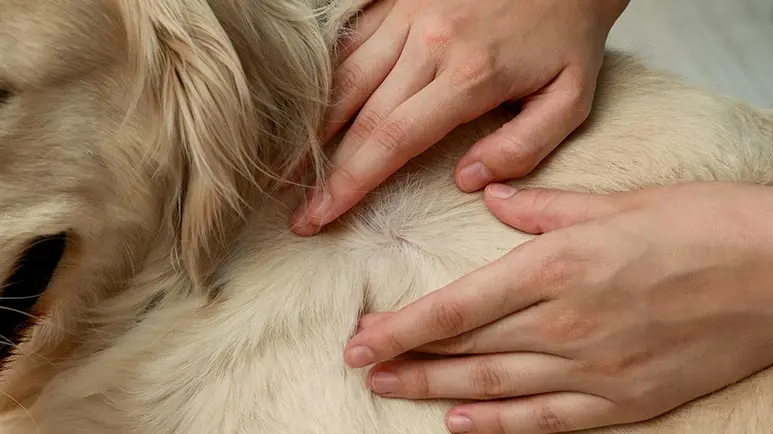Three Skin Conditions That Can Cause Your Pet Extreme Pain
These aren't your run-of-the-mill skin disorders like atopic dermatitis or hot spots. One may start out as red, itchy skin on your pet's face or ears, and spread to the rest of your pet's body, leading to painful, open blisters.

STORY AT-A-GLANCE
- Skin disorders in dogs and cats are quite common, but in addition to everyday conditions like atopic dermatitis and hot spots, there are several so unusual you may not have heard of them
- Three rare skin diseases in pets are pemphigus foliaceus, calcinosis cutis and hepatocutaneous syndrome
- Pemphigus foliaceus is an autoimmune disease that causes pustules and crusting on the surface of the skin
- Calcinosis cutis is characterized by calcium salt deposits in the skin
- Hepatocutaneous syndrome is characterized by the death of certain types of cells in the skin, and unfortunately, the presence of this condition indicates the dog has severe internal disease
Editor's Note: This article is a reprint. It was originally published March 1, 2017.
As you may be aware as a pet parent, a lot can go wrong with your animal companion's skin. In fact, the number of canine and feline skin disorders veterinarians encounter is mind-boggling.
There’s the all-too-common allergic skin condition called atopic dermatitis. There are also hot spots, lick granulomas and infectious skin diseases caused by parasites, bacteria, fungi and viruses. There’s even a skin condition that can be triggered by the bite of just one flea called flea allergy dermatitis.
There are also several strange and unusual skin diseases that can plague your dog (or less likely, your cat). Veterinary journal dvm360 discussed three examples: pemphigus foliaceus, calcinosis cutis and hepatocutaneous syndrome.
Three Rare Pet Skin Disorders
- Pemphigus foliaceus — Pemphigus foliaceus (PF) is an autoimmune skin disease that occurs primarily in dogs. It causes pustules (pus-filled blisters) and crusting on the surface of your pet's skin. The skin beneath the crusts is raw and can be painful.
The pustules are often first seen on the face and ears, but can spread to other areas of your pet's body. There can also be thickening and cracking of the footpads. In cats, the claw fold is a commonly affected site. Other symptoms can include:
- Red, itchy skin
- Depression
- Involvement of the gums and lips
- Difficulty walking if the footpads are involved
- Swollen lymph nodes
- Fever
- Generalized swelling
- Secondary bacterial infections
The disorder can be idiopathic (meaning the cause can’t be identified). It can also be triggered by certain drugs, including the spot-on flea/tick treatment ProMeris (metaflumizone), Tagamet (cimetidine) and various antibiotics.
To confirm a diagnosis of pemphigus foliaceus, your veterinarian will need to take skin samples for biopsy. Traditional treatment involves long-term (usually lifelong) corticosteroid therapy. Often a second drug is also given to reduce the side effects of the corticosteroid.
This is why many owners seek the advice of integrative vets for these cases, as a lifetime of steroids can have side effects that are equally as bad or worse than the crusty skin.
Integrative vets focus on modulating the immune system with Chinese herbs and nutraceuticals, along with microbiome evaluation and appropriate detoxification to help manage these difficult cases. Dogs with any autoimmune disease (including PF) should never be vaccinated. - Calcinosis cutis — Calcinosis cutis is characterized by calcium salt deposits in the skin. It is commonly caused by hyperglucocorticoidism, which occurs either as a result of the administration of corticosteroids (e.g., prednisone, prednisolone), or hyperadrenocorticism (Cushing's disease).
A far less common cause of the disorder is calcium absorption through the skin when a pet comes in contact with an ice melt product containing calcium chloride (e.g., MELT or Road Runner Ice Melt), or a calcium fertilizer such as CalMax or Foli-Cal.
Dogs at highest risk for calcinosis cutis are English Bulldogs and dogs receiving corticosteroid injections.
Calcinosis cutis lesions are typically white to pink in color and the skin around them is red and swollen. The lesions can be extremely painful for some pets, and usually develop on the back of the neck first and then spread.
An initial diagnosis of calcinosis cutis can be made with X-rays, but a definitive diagnosis requires biopsy samples. The standard treatment for the disorder is to stop corticosteroids, and resolve secondary infections and systemic disease as appropriate.
Calcium deposits in the skin usually dissolve two to 12 months after steroids are discontinued or Cushing’s disease is successfully managed. Pets who have been diagnosed with calcinosis cutis should never receive steroid therapy or vaccines again.
Although conventional vets don't have much to offer dogs with this condition, integrative veterinarians have found several homeopathic remedies can be very valuable in helping to dissolve the deposits, along with supplements that help naturally decrease cortisol and nourish the adrenal glands.
There are several adaptogenic herbs such as rhodiola, ashwagandha and holy basil that can naturally lower cortisol levels, in addition to reishi and cordyceps medicinal mushrooms.
There are also substances that can be very beneficial at supporting healthy skin rejuvenation such as collagen, vitamins C and E and astaxanthin. - Hepatocutaneous syndrome — Fortunately, hepatocutaneous syndrome in dogs is rare, since the prognosis is poor. The condition is most often seen in senior dogs with chronic liver disease, and is characterized by the death of certain types of cells in the skin due to amino acid starvation.
Skin lesions are typically the first sign in a dog with hepatocutaneous syndrome. The wounds are most often seen on paw pads, elbows, hocks and muzzles. Many dogs with the condition have trouble walking as a result of damage to the paw pads.
Diagnosis of hepatocutaneous syndrome typically requires a number of diagnostic tests, including a complete blood count (CBC), serum chemistry profile and urinalysis. An abdominal ultrasound will usually show a honeycomb pattern in the liver.
However, as with the other two skin disorders discussed above, a skin biopsy is the gold standard for diagnosing hepatocutaneous syndrome.
Sadly, the presence of this condition indicates your dog is dealing with severe internal disease. Traditional treatment involves multiple hospitalizations for intravenous injections of a crystalline amino acid solution. Due to the cost of the treatment and the poor prognosis, most owners choose supportive therapy.
This typically includes increased protein intake and fatty acid supplementation. Sometimes corticosteroid therapy is given, but in addition to the usual side effects, most patients become resistant to it, and it also significantly increases the risk of diabetes, so it’s not recommended.
Since the skin of dogs with hepatocutaneous syndrome doesn't heal well, secondary infections are extremely common. The sooner these poor dogs can visit an integrative veterinarian, the better. Switching to a homemade, balanced and meat-based diet (rich with bioavailable amino acids, vitamin K-rich veggies and anti-inflammatory essential fatty acids) can be a tremendous help.
Additionally, dogs with this condition can benefit from milk thistle, choline, IV vitamin C, SAMe, glutathione and high doses of the intracellular antioxidant ubiquinol.











